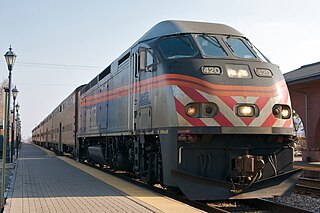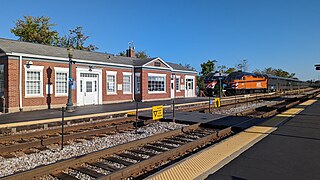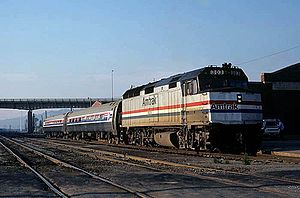
Metra is the primary commuter rail system in the Chicago metropolitan area serving the city of Chicago and its surrounding suburbs via the Union Pacific Railroad, BNSF Railway, and other railroads. The system operates 242 stations on 11 rail lines. It is the fourth busiest commuter rail system in the United States by ridership and the largest and busiest commuter rail system outside the New York City metropolitan area. In 2023, the system had a ridership of 31,894,900, or about 152,400 per weekday as of the fourth quarter of 2023. The estimated busiest day for Metra ridership occurred on November 4, 2016—the day of the Chicago Cubs 2016 World Series victory rally.

The Illinois Central Railroad, sometimes called the Main Line of Mid-America, was a railroad in the Central United States. Its primary routes connected Chicago, Illinois, with New Orleans, Louisiana, and Mobile, Alabama, and thus, the Great Lakes to the Gulf of Mexico. Another line connected Chicago west to Sioux City, Iowa (1870), while smaller branches reached Omaha, Nebraska (1899) from Fort Dodge, Iowa, and Sioux Falls, South Dakota (1877), from Cherokee, Iowa. The IC also ran service to Miami, Florida, on trackage owned by other railroads.

The Illinois Service, branded Amtrak Illinois, comprises three passenger rail routes operated by Amtrak in the American state of Illinois. The Illinois Service is funded primarily by the Illinois Department of Transportation (IDOT) and falls under the broader Amtrak Midwest brand.

The North Coast Hiawatha was a streamlined long-distance passenger train operated by Amtrak between Chicago, Illinois, and Seattle, Washington.

The Iowa Interstate Railroad is a Class II regional railroad operating in the central United States. The railroad is owned by Railroad Development Corporation of Pittsburgh, Pennsylvania.

The Illini and Saluki are a pair of passenger trains operated by Amtrak along a 310-mile (500 km) route between Chicago and Carbondale, Illinois. They are part of Amtrak's Illinois Service and are primarily funded by the state of Illinois. The service provides two daily roundtrips; Saluki being the morning trains and Illini the afternoon trains. The route is coextensive with the far northern leg of the long-distance City of New Orleans.

The BNSF Line is a Metra commuter rail line operated by the BNSF Railway in Chicago and its western suburbs, running from Chicago Union Station to Aurora, Illinois. In 2010, the BNSF Line continued to have the highest weekday ridership of the 11 Metra lines. While Metra does not refer to its lines by particular colors, the BNSF line's color on Metra timetables is "Cascade Green," in honor of the Burlington Northern Railroad.

The Milwaukee District West Line (MD-W) is a Metra commuter rail line in Chicago, Illinois, and its western suburbs. Metra does not refer to any of its lines by a particular color, but the timetable accents for the Milwaukee District West line are dark "Arrow Yellow," honoring the Milwaukee Road's Arrow passenger train. Trains are dispatched from the Canadian Pacific Kansas City Railway's American headquarters in Minneapolis.

Joliet Union Station was a train station in Joliet, Illinois that served Amtrak long-distance and Metra commuter trains. It was replaced by the new Joliet Transportation Center in 2018, a train station that was constructed adjacent to the Union Station's location. Train service to Joliet Union Station permanently ceased in September 2014. The station is 37.0 miles (59.5 km) from Chicago Union Station on the Heritage Corridor, and 40.1 miles (64.5 km) from Chicago LaSalle St. Station on the Rock Island District.

Alton Regional Multimodal Transportation Center, also known as Alton station, is a station in Alton, Illinois, that is served by Amtrak's Lincoln Service and the Texas Eagle. This was also a stop for the Ann Rutledge until April 2007. It is one of three Amtrak stations in the St. Louis metropolitan area; the other two are the Gateway Multimodal Transportation Center located in downtown St. Louis, and the Amtrak station in Kirkwood, Missouri.

Elgin is one of three stations on Metra's Milwaukee District West Line in Elgin, Illinois. The station is 36.6 miles (58.9 km) away from Chicago Union Station, the eastern terminus of the line. In Metra's zone-based fare system, Elgin is in zone 4. As of 2018, Elgin is the 116th busiest of Metra's 236 non-downtown stations, with an average of 411 weekday boardings.

The Land O'Corn was a streamlined passenger train operated by the Illinois Central Railroad between Chicago, Illinois, and Waterloo, Iowa, from 1941 until 1967. Its inception was due in no small part to John W. Rath of Ackley, IA and part owner of the Rath Packing Co. of Waterloo, Iowa as well as a member of the Illinois Central's board of directors. It featured a wide range of equipment over its existence, including self-propelled Motorailers and steam locomotives, before finally adopting conventional diesel locomotives and lightweight cars. The Illinois Central discontinued the Land O'Corn in 1967; Amtrak later operated the Black Hawk over part of its route.

The Dubuque Intermodal Transportation Center(DITC) is a bus station located in Dubuque, Iowa. It serves as the new transfer center for Dubuque's bus system, between Jule buses and intercity buses serving Dubuque, and as a transfer point between other modes of land transportation.
Illinois High Speed Rail refers to a set of planned high speed rail lines connecting Chicago Union Station to various parts of the state and beyond. Two lines already offer increased speeds.

The Freeport Subdivision is a railroad line in Illinois which runs from 16th Street in downtown Chicago to Freeport, Illinois. It is owned and operated by the Canadian National Railway (CN). As of 2016 the line is almost exclusively freight-only, with only a small segment within Chicago, between 21st Street in Chinatown and Ashland Avenue in Bridgeport, hosting Amtrak and Metra passenger trains.
The Quad Cities is a planned Amtrak Illinois Service intercity passenger train that will operate between Chicago and Moline in the US state of Illinois. The train will duplicate the route and stations of the Carl Sandburg and Illinois Zephyr between Chicago and Wyanet using track owned by BNSF. On the Wyanet–Moline segment, which will include a station at Geneseo, the train will use track owned by Iowa Interstate Railroad.

Moline station is a proposed train station in Moline, Illinois, intended to serve as the terminus of the Quad Cities Amtrak line. Construction has begun and the station was initially expected to open by 2019, though it remains incomplete as of 2024.

Amtrak Midwest is a brand name applied by Amtrak to its state-supported routes in the Midwest states of Illinois, Michigan, Wisconsin, and Missouri. As of 2024, Amtrak Midwest consists of ten named trains:
The Rockford Intercity Passenger Rail is a proposed Metra inter-city rail service between Chicago and Rockford, Illinois. The project is being led by the Illinois Department of Transportation (IDOT) funded with $275 million through the Rebuild Illinois capital plan. The route is expected to begin by late 2027, reinstating rail service to Rockford for the first time in over 40 years after the discontinuation of Amtrak's Black Hawk in 1981.

















